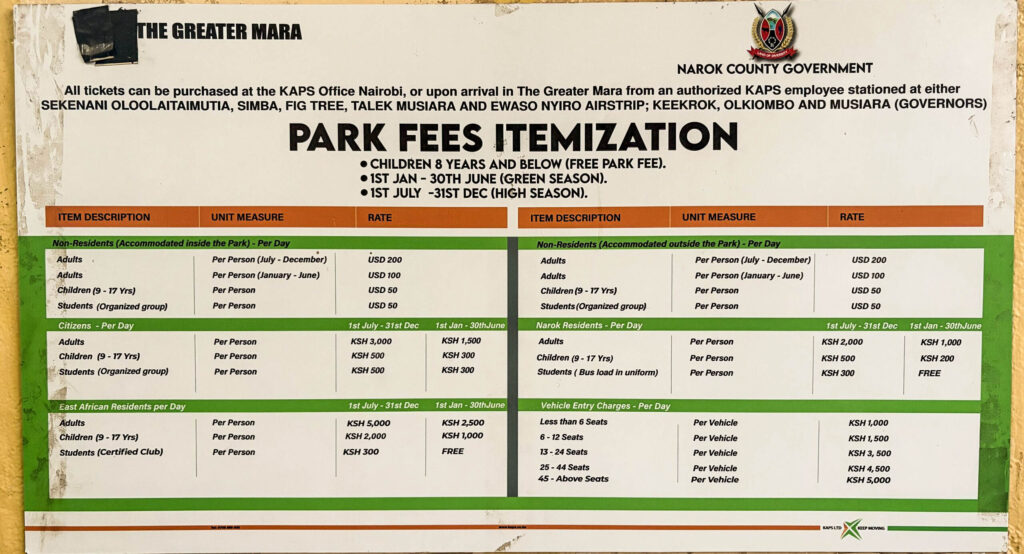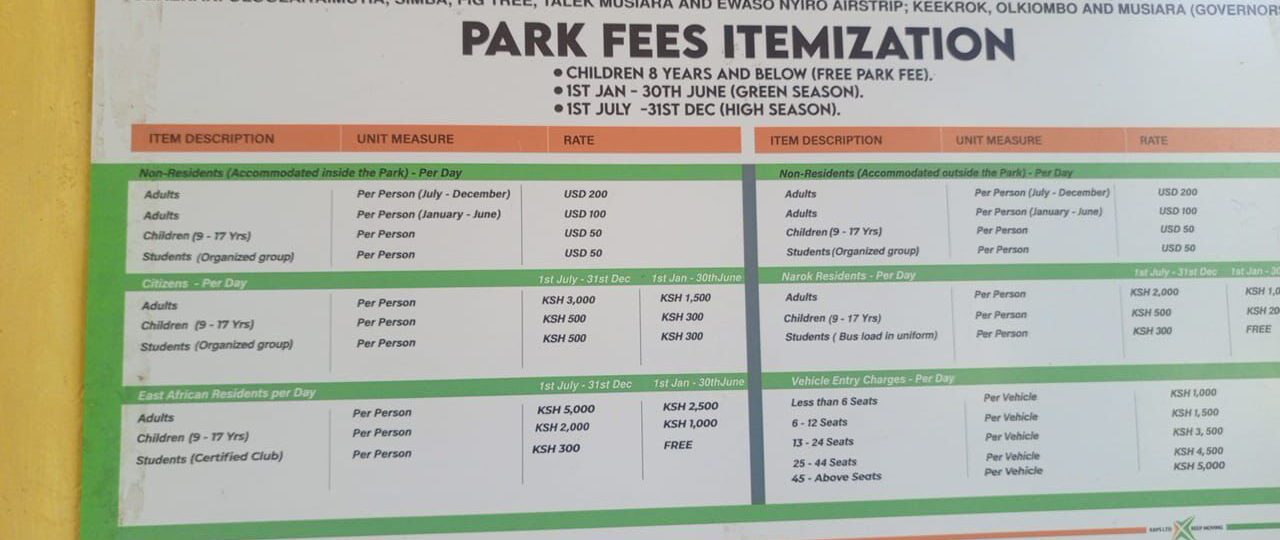Masai Mara Park Fees & Entrance Rates — Full Breakdown 2025/2026
Introduction
If you’re planning a safari to the Masai Mara in 2025, one of the most important things to get right is the park entry fees. These rates vary depending on your nationality or residency, season, and vehicle type. Using the official fee board from Narok County and multiple trusted sources, this article delivers the definitive guide to Masai Mara park fees. Whether you’re a Kenyan citizen, East African resident, or foreign traveler, you’ll know exactly what to expect. Let’s dive in.

Why Park Fees Matter
Every shilling or dollar you pay to enter the Masai Mara supports critical functions: anti‑poaching enforcement, habitat maintenance, ranger salaries, infrastructure, and community development. Without these funds, wildlife and ecosystems would suffer. Thus, the park fees are both your ticket and your contribution to preserving Kenya’s crown jewel.
Non‑Residents: What You’ll Pay
Non-resident (foreign tourist) fees are among the highest. Here’s what the 2025 rates show:
- Low Season (Jan 1 – June 30): USD 100 per adult per day
- High Season (Jul 1 – Dec 31): USD 200 per adult per day
- Children (9–17 yrs): USD 50 per day (all year)
- Children ≤ 8 yrs: Free entry
These rates are consistent regardless of whether your accommodation is inside or outside the reserve.
Kenyan Citizens / Nationals
Citizens enjoy heavily subsidized rates:
- Low Season: KSh 1,500 for adults; KSh 300 for children (9–17 yrs)
- High Season: KSh 3,000 for adults; KSh 500 for children
- Children ≤ 8 yrs: Free
Always carry your national ID or valid Kenyan passport to validate the rate. Masai Mara+2Wildlife Kenya Safari+2
Narok County Residents
Residents of Narok County — where much of the reserve lies — benefit from even lower rates:
- Low Season: KSh 1,000 for adults; KSh 200 for children
- High Season: KSh 2,000 for adults; KSh 500 for children
- Children ≤ 8 yrs: Free
Some student groups (bus in uniform) may enter free or at very low cost, as shown on the board.
East African Residents / Citizens
For residents of other EAC countries (Tanzania, Uganda, Rwanda, Burundi, South Sudan):
- Low Season: KSh 2,500 per adult; KSh 1,000 for children (9–17 yrs)
- High Season: KSh 5,000 per adult; KSh 2,000 for children
- Children ≤ 8 yrs: Free
Proof of residency must be shown at entry. Masai Mara+2Wildlife Kenya Safari+2
Vehicle Entry Fees — Don’t Overlook This
Every vehicle entering the reserve pays a fee based on seating capacity:
- < 6 seats: KSh 1,000
- 6 – 12 seats: KSh 1,500
- 13 – 24 seats: KSh 3,500
- 25 – 44 seats: KSh 4,500
- 45+ seats: KSh 5,000
This is a daily fee and must be incorporated into the overall safari cost. It applies irrespective of whether the vehicle’s occupants are inside or outside the reserve.
Ticket Validity & Access Times
- Entry tickets are valid for 12 hours (commonly 6 am to 6 pm)
- Guests staying outside the reserve must exit by evening
- Overstaying, late exit, or re-entry often triggers additional fees
How These Rates Compare to Recent Past
- Before 2023, tickets often covered 24 hours. Now, they changed to 12-hour validity.
- The hike to USD 200 in peak season is a major jump from earlier years.
- Kenyan citizen and EAC rates have also been scaled upwards to reflect inflation and conservation needs.
Tips for Your Tour Planning
- Include fees in quotes — Always ensure your safari package includes both person entry fees and vehicle entry charges.
- Check IDs & documentation — EAC / citizen discounts require valid ID (passport, national ID).
- Plan within the time window — Do not overstay your ticket validity, or you may pay extra.
- Budget for peak season — Costs roughly double in July–December.
- Explore group tours / shared vehicles — The vehicle fee per person goes down with more sharing.
- Book in advance — Some gates or lodges may allow pre‑payment to avoid queue delays.
- Remember electric / cashless options — Many gates now accept M‑Pesa or card; carry USD and KSh as backups.
Why These Fees Matter to Your Clients
Your website visitors deserve transparency. Presenting the correct 2025 fees will help them:
- Budget accurately for their safari
- Avoid being overcharged by unscrupulous operators
- Understand the disparities between citizen, EAC, and non‑resident rates
- Appreciate how their contributions support conservation and local communities
By using the actual fee board data, your “Plan My Kenyan Tour” site will gain credibility and trust among travelers — and that helps with SEO too.
Conclusion
The updated Masai Mara park fees for 2025 are significantly higher than in earlier years, especially for non‑residents during the high season. The new 12‑hour validity, steep vehicle charges, and tiered pricing for different visitor types mean that careful planning is essential. Use the rates from the official fee board (as scanned in your image) combined with supporting sources for accuracy.





